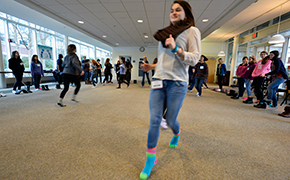Instructor Insights pages are part of the OCW Educator initiative, which seeks to enhance the value of OCW for educators.
This Workshop at MIT page provides context for how the workshop materials published on OCW were used at MIT. It is part of the OCW Educator initiative, which seeks to enhance the value of OCW for educators.
Workshop Overview
This page focuses on the Girls Who Build: Make Your Own Wearables Workshop as it was facilitated by Kristen Railey in December 2014.
The Make Your Own Wearables Workshop introduces high school girls to computer science and electrical and mechanical engineering through wearable technology. This one-day workshop, developed by MIT Lincoln Laboratory, consists of hands-on projects in manufacturing and wearable electronics. These include 3D printing jewelry and laser cutting a purse, as well as programming LEDs to light up when walking. Participants learn the design process, 3D computer modeling, and about machine shop tools, in addition to writing code and building a circuit.
Intended Workshop Outcomes
Workshop Goals for Participants
- Discover what engineering is
- Challenge stereotypes about who engineers are and what they do
- Gain exposure to the design process
- Explore 3D computer modeling
- Design a bracelet using SOLIDWORKS
- Code a FLORA in Arduino for a wearable circuit with pressure sensor and LEDs
- Tour a rapid prototyping machine shop
I hope educators who facilitate this workshop in the future will come up with more wearable circuit ideas.
—Kristen Railey
In the following pages, Kristen Railey describes various aspects of how she and the volunteers facilitated the Girls Who Build: Make Your Own Wearables Workshop in December 2014.
- Inspiration for the Workshop
- Framing Engineering as Problem Solving
- Supporting Girls with Different Levels of Coding Experience
- Preparing Volunteers
- Advice for Educators
Workshop Information
Prerequisites
None
Upcoming Workshop Offerings
- December 2015
- Spring 2016
Participant Information

Typical Student Background
In December 2014, participants were girls in grades 9-12. About half of them came to the workshop with previous programming experience. Many of the girls did not have experience with computer-aided design or 3D printing.


 Room 1 of 2
Room 1 of 2 
